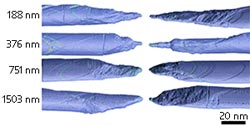Nanowires: The long and short of breaking

Examples of failure in four different lengths of nanowire as a result of tensile stress. Only nanowire sections close to the fracture are shown. A short (188 nanometer (nm)) nanowire fails through gradual, ductile deformation (top). A long (1,503 nm) nanowire fails abruptly through a brittle or localized shear failure (bottom).<br><br>© 2012 American Chemical Society<br>
Most materials will break when a force is applied to an imperfection in their structure — such as a notch or dislocation. The behavior of these imperfections, and the resulting breakage, differ markedly between small structures, such as nanowires, and larger, bulk materials.
However, scientists lacked complete understanding of the precise mechanics of nanowire breakages, owing in part to inconsistent behavior in experiments. These inconsistencies are now resolved thanks to numerical simulations by Zhaoxuan Wu and his co-workers at the A*STAR Institute for High Performance Computing, Singapore, and collaborators in the USA1.
The researchers focused on metal nanowires with a so-called 'face-centered cubic crystal structure' because they exhibit two different failure modes. Previous experiments by other groups showed that these nanowires can break as the result of a ductile process, in which a narrow neck is formed smoothly and continuously before failure. Other experiments showed that the failure was caused by a brittle fracture, which happened suddenly. To complicate matters further, atom-scale simulations of these experiments predicted that only ductile necking should be occurring.
Most materials will break when a force is applied to an imperfection in their structure — such as a notch or dislocation. The behavior of these imperfections, and the resulting breakage, differ markedly between small structures, such as nanowires, and larger, bulk materials. However, scientists lacked complete understanding of the precise mechanics of nanowire breakages, owing in part to inconsistent behavior in experiments. These inconsistencies are now resolved thanks to numerical simulations by Zhaoxuan Wu and his co-workers at the A*STAR Institute for High Performance Computing, Singapore, and collaborators in the USA (1).
The researchers focused on metal nanowires with a so-called 'face-centered cubic crystal structure' because they exhibit two different failure modes. Previous experiments by other groups showed that these nanowires can break as the result of a ductile process, in which a narrow neck is formed smoothly and continuously before failure. Other experiments showed that the failure was caused by a brittle fracture, which happened suddenly. To complicate matters further, atom-scale simulations of these experiments predicted that only ductile necking should be occurring.
The A*STAR-affiliated researchers contributing to this research are from the Institute for High Performance Computing
Journal information
Wu, Z., Zhang, Y.-W., Jhon, M. H., Gao, H. & Srolovitz, D. J. Nanowire failure: long = brittle and short = ductile. Nano Letters 12, 910–914 (2012).
Media Contact
All latest news from the category: Materials Sciences
Materials management deals with the research, development, manufacturing and processing of raw and industrial materials. Key aspects here are biological and medical issues, which play an increasingly important role in this field.
innovations-report offers in-depth articles related to the development and application of materials and the structure and properties of new materials.
Newest articles

Sea slugs inspire highly stretchable biomedical sensor
USC Viterbi School of Engineering researcher Hangbo Zhao presents findings on highly stretchable and customizable microneedles for application in fields including neuroscience, tissue engineering, and wearable bioelectronics. The revolution in…

Twisting and binding matter waves with photons in a cavity
Precisely measuring the energy states of individual atoms has been a historical challenge for physicists due to atomic recoil. When an atom interacts with a photon, the atom “recoils” in…

Nanotubes, nanoparticles, and antibodies detect tiny amounts of fentanyl
New sensor is six orders of magnitude more sensitive than the next best thing. A research team at Pitt led by Alexander Star, a chemistry professor in the Kenneth P. Dietrich…





















